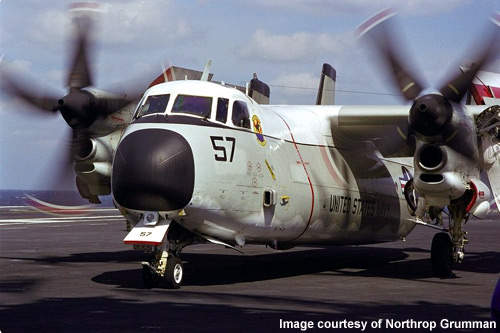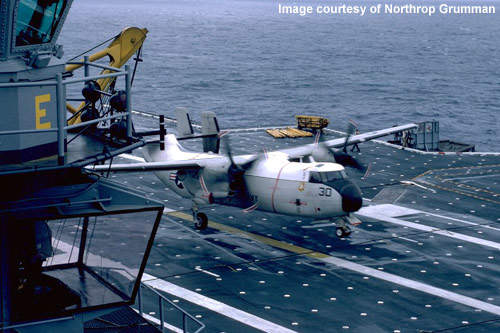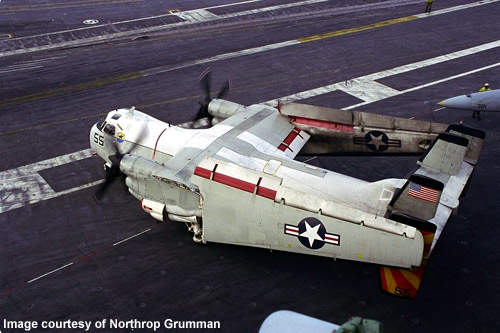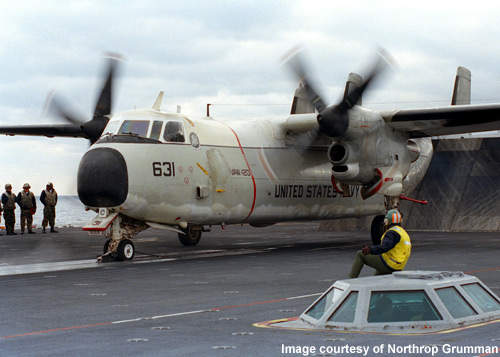The C-2 greyhound aircraft is a high-wing carrier on-board delivery (COD) aircraft used by the US Navy. Designed to land on aircraft carriers, the monoplane cargo aircraft provides critical logistics support to carrier strike groups.
The aircraft is mainly used to transport high-priority cargo, mail and passengers between carriers and shore bases, and can deliver high-priority items like jet engines, afterburners and special stores.
Aerospace defence and technology company Northrop Grumman Aerospace Systems (Northrop Grumman) started producing the aircraft in 1965 after a prototype was tested successfully in the previous year. Later in 1973, a new version of the aircraft called the C-2A was made by overhauling the C-2 Greyhound for improved operational life. The overhaul mainly included replacement of the airframes.
A total of 39 new C-2A aircraft were ordered in 1984 and they lasted until 1987 when a new model named the reprocured C-2A or C-2A(R) replaced the older model.
Production of the modernised version began in 1985. Delivered in 1990, the aircraft’s modernisation process included several improvements in the airframe and avionic systems over those in the C-2A.
Northrop Grumman is currently working on the resupply of the upgraded C-2A version. In November 2008, the company also obtained a $37m contract for the maintenance, logistics and aviation administration services over five years for the C-2A fleet assigned to air test and evaluation squadron 20 (VX-20) at Patuxent River.
Greyhound service life extension programme (SLEP)
A service life extension programme (SLEP) is being carried out to improve the operating service life of the reprocured aircraft, achieving a viable and economically maintainable platform until it is replaced. The programme will increase its service life from 15,020 to 36,000 landings and from 10,000 to 15,000 flight hours. The SLEP involves structural enhancements to the centre wing, an aircraft rewire, a new propeller system and improvement of the avionics systems.
Navigational upgrades such as the addition of a global positioning system (GPS), the dual CAINS II navigation system, crash-survivable flight incident recorders and a ground proximity warning system are also included in the programme.
Further, a mandate issued by Congress and the chief of naval operations provided for incorporation of two passenger-carrying safety requirements, namely the traffic alert and collision avoidance system (TCAS) and the terrain avoidance warning system (TAWS) in the extension programme. The landing limit of most of the airframes is quickly approaching and the SLEP, upon successful completion, will improve the operational life of the aircraft till 2027.
While all the existing fleet of 36 C-2As is being upgraded in the SLEP, the first upgraded C-2A(R) took off from the NAVAIR Depot North Island on 12 September 2005. Development and installation of the SLEP for this aircraft took three and a half years. As of 2009, a second airframe is close to completion, and the rest of the 34 aircraft are anticipated to take off in the following five years.
C-2A carrier delivery aircraft design
Designed to deliver a payload of up to 10,000lb over a distance exceeding 1,000nm, the C-2A shares the same model of wings and empennage employed in the E-2 Hawkeye, changes such as a wider fuselage, shorter snub nose and addition of a rear loading lamp have been employed in the greyhound.
The C-2A was originally powered by two Allison T56-A-425 turboprop engines and four-bladed Hamilton-Sundstrand constant-speed propellers. Later, a maintenance upgrade replaced the older propeller by the new eight-bladed NP2000 propeller from Hamilton Sundstrand. Replacing the previous electro-mechanical, steel spar, four-bladed propeller, the NP2000 is a digitally controlled and all-composite propeller.
An undercarriage with main gears is fitted to each engine nacelle and at the fuselage’s forward-most portion, a nose wheel is fitted. The wing systems are foldable and twist down, and then fold towards the empennage, just outboard of each engine nacelle, thus improving the carrier storage. Fitted into streamlined nacelles, the engines are mounted under each wing.
Greyhound’s cabin is designed to be flexible to readily accommodate cargo, mail, passengers and litters in medical evacuation missions or a mix of these.
Straight-in rear cargo loading and downloading are enabled by the inclusion of a large aft cargo ramp and door, and a powered winch in the design to allow for fast turnarounds. A cage system helps to tie down the cargo and restrain it from the arresting and loads during carrier operation.
Northrop Grumman has equipped the aircraft with modified fowler-type flaps, and hydraulically powered irreversible flight controls with an independent hydraulic backup system.
Ultra-high-frequency (UHF) radio navigation aids such as GPS, TACAN (tactical air navigation), dual VOR (VHF omni-directional range), UHF/DF (ultra-high-frequency / direction finder), LF/ADF (low-frequency / automatic direction finder) and weather radar; and communications equipment such as high frequency (HF) and very high frequency (VHF) were provided in the aircraft. The TCAS, TAWS and ARC-210 (airborne radio communication) radios were added later.
Airdrop capability
The C-2A has open-ramp flight capability which enables airdrop of personnel and cargo or other supplies from a carrier-launched aircraft. Ground power self-sufficiency in remote areas and an auxiliary power unit onboard for starting the engine give the C-2A high operational versatility.
The C-2A is also an approved special warfare asset. It can airdrop the inflatable combat rubber raiding craft of a SEAL (sea air land) platoon out of its ramp. It deploys the platoon after the release has been made, thus enabling the SEALs to operate in close proximity to enemy camps. The airdrop capability also enables the aircraft’s utility as a search and rescue (SAR) platform to airdrop life rafts and provisions.
C2-A operators
Currently the naval aircraft is being operated by Carrier Airborne Early Warning Squadron One Two Zero (VAW-120), Fleet Logistics Support Squadron 30 (VRC-30) and Fleet Logistics Support Squadron 40 (VRC-40). ‘Providers’ at NAS North Island and Detachment Five (at NAF Atsugi, Japan) of VRC-30 are also flying the C-2As. VRC-40 is using the aircraft for its ‘Rawhides’ stationed at NAS Norfolk, while VAW-120 is using the aircraft for its ‘Greyhawks’ stationed at the same location.
VAW-120, the US Navy Fleet Replacement Squadron, is engaged in training aircrew men, naval flight officers and new pilots for the C-2A Greyhound as well as E-2C Hawkeye aircraft.
The C2-A has, in the past, provided support to the US Navy for European and Mediterranean theatre commands, carrier strike groups during Operations Desert Shield and Desert Storm, and Operation Enduring Freedom during the war in Afghanistan.








